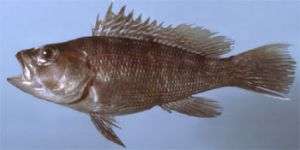Researchers Find Aquaculture Promising Method to Grow Black Sea Bass

Black sea bass is an important recreational and commercial fishery along the Atlantic coast of the US, but landings have decreased in recent decades as the demand for this tasty fish in seafood and sushi markets has risen. In an attempt to meet that demand, NOAA researchers recently evaluated the potential of black sea bass for commercial aquaculture and found promising results.
After two separate culture trials over a period of four years at the NOAA National Marine Fisheries Service lab in Milford, Conn., fisheries biologists found that sea bass can be grown from larvae to adults in recirculating aquaculture systems (RAS), eating a diet of commercial pellet feeds.
“Black sea bass are a slow growing fish in the wild but show great promise as an aquaculture species because of its rapid growth in RAS, “ said study leader Dean Perry. “We were able to induce spawning and successfully culture black sea bass to adults, and had bass attain weights in under two years that take wild stocks three years or more to achieve. We tried a number of commercial feeds with different percentages of protein and lipids, and the bass clearly had a preference.”
Perry and colleagues found that the nutritional composition of the feeds used is important, and that bass may require different feeds at different life stages to get the best growth in the least amount of time. RAS temperature, salinity and alkalinity levels also were found to affect growth rates.
Black sea bass range from Cape Cod to Florida but are most abundant off the Mid-Atlantic coast. Also called black will, chub or blackfish, black sea bass usually live in coastal waters with rocky bottoms around reefs, wrecks, piers and other structures, and change colors from black to gray, brown and deep blue to blend into their environment. All black sea bass are hermaphrodites, beginning life as females and then changing into males generally between two and five years of age. Adults migrate offshore and overwinter in deep waters, returning in the spring to shallower waters.
Fisheries managers recognize two stocks of black sea bass, one south and one north of Cape Hatteras, North Carolina. Seasonal spawning begins in February for southern stocks and by late spring in New England waters. The fish, related to groupers, migrate to deeper offshore waters for the winter and return to coastal habitats in the spring, feeding on crabs, lobster, shrimp, squid and mollusks. Black sea bass are harvested commercially by fish pots and otter trawls and sought by recreational anglers using hook and line.
According to the Massachusetts Division of Marine Fisheries, the largest black sea bass caught by an angler in Massachusetts's waters weighed eight pounds, and off Florida the record is just over five pounds. Most common, however, is a 12-inch fish generally weighing about one pound.
While optimistic about their results, Perry and study colleagues note that future aquaculture research efforts should look at understanding the factors that control growth, investigating optimal culture temperatures, lighting conditions, reproductive physiology, and the nutritional requirements of various life stages of black sea bass.
The Milford Laboratory, part of the Northeast Fisheries Science Center of NOAA Fisheries, emphasizes aquaculture and habitat-related research. Its aquaculture program includes studies of fish and shellfish to develop methods suitable for commercial use as well as stock enhancement and restoration. The Lab, founded in 1931, also studies nearshore habitats to determine what characteristics make a habitat suitable for a particular species.
Source: NOAA

















